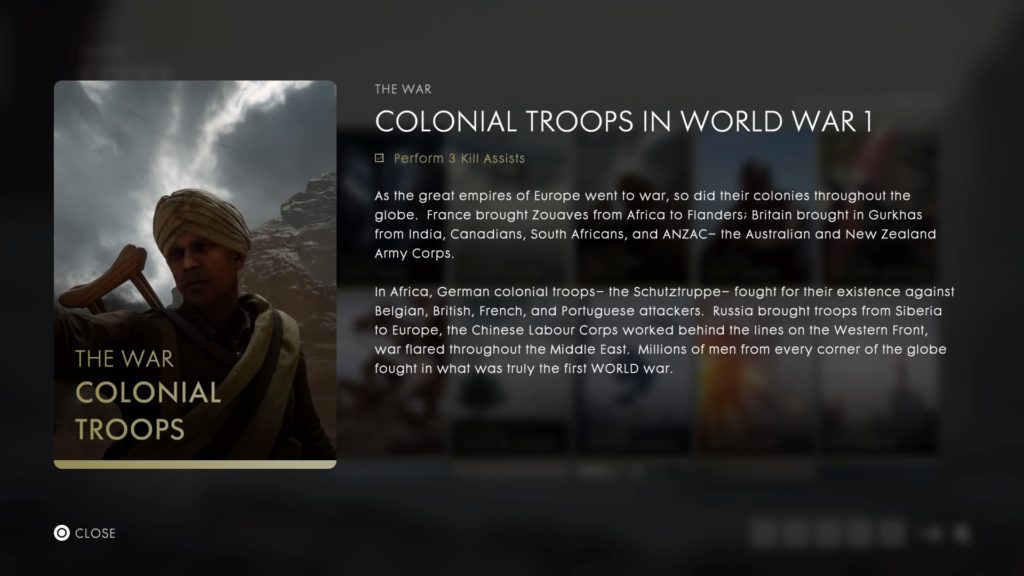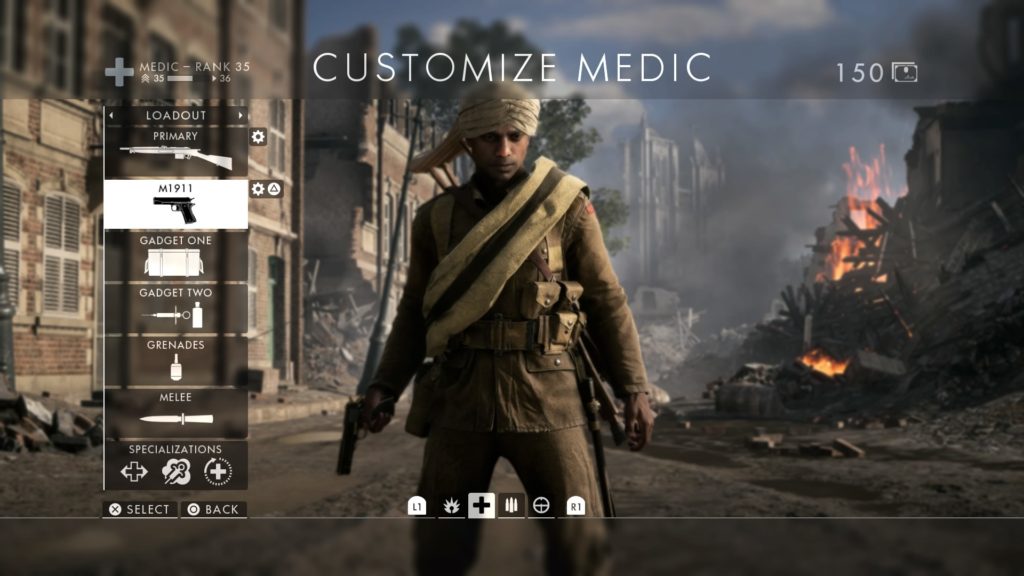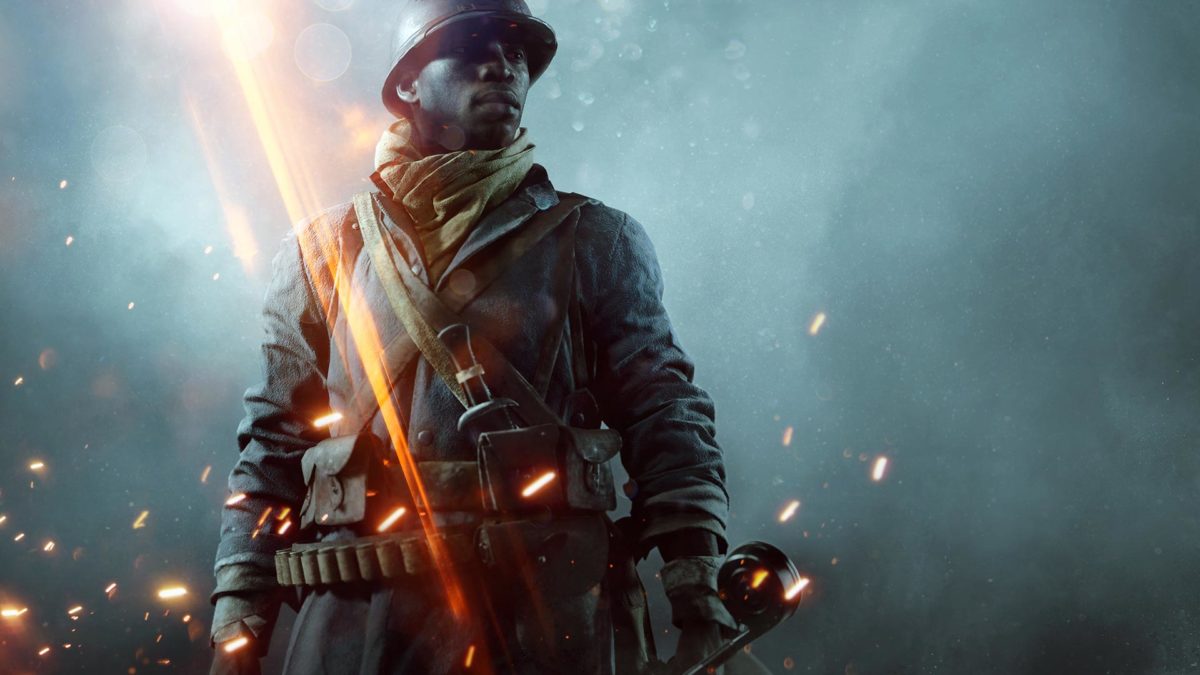The history of the First World War (1914–1918) cannot be fully understood without understanding the important role that colonialism played in the war’s development. The conflict did not only earn the title of the First World War because of its geographical reach, but because its participants came from every corner of the world. This was to a large extent the consequence of the enlistment, both forcibly and voluntarily, of men from across the colonial empires of the European powers fighting for supremacy. The armies that fought in the war were not exclusively made up of white men of European ancestry as traditionally depicted in popular culture, but were instead multiracial and multicultural armies.
In 2016, the First World War first-person shooter Battlefield 1 took on the daunting task of moving beyond the Eurocentric confinements of past representations of the war. Daniel Berlin, the lead game designer at DICE, explained that “When we set out on this game, we wanted to depict not just the common view of what the war was like. We wanted to challenge some preconceptions. We want to delve into some of the unknowns of World War One. Maybe people don’t know that this person fought or that person fought, that this army was involved.” Against the backdrop of this firm commitment to presenting a diverse depiction of the First World War and challenging traditional norms surrounding the conflict, the presence of colonialism in the game seems inevitable. As a first-person shooter, how does Battlefield 1represent the participation of colonial soldiers? What space does colonialism inhabit within the game and how is it contextualized?
Representing Colonialism in Battlefield 1

Battlefield 1’s single player campaign consists of six different narratives (“War Stories”). Four take place in Europe (France, the skies of Great Britain, and Italy), one takes place in Turkey during the Gallipoli campaign, and one takes place during the Arab Revolt. Colonial soldiers are noticeably absent in these narratives. The majority of them centers on a white, male protagonist. The shortest narrative (approximately 15 minutes long) centers on a nameless African-American soldier. Only the last of the narratives, which follows the only female protagonist in the game, briefly touches on imperialism within the context of the Arab Revolt against the Ottoman Empire and the post-war Near East. However, the narrative is far more concerned with connecting the First World War to contemporary conflicts in the Near East, stating at the end that, “The war for oil continues to this day.”
The presence of colonial soldiers and domiciled soldiers of color is made more visible in the game’s multiplayer features. The game features four different classes that the player can choose to play as, all of which are represented by one unchangeable model. Out of six playable factions in the base game (Italy, Germany, Great Britain, the United States, Austria-Hungary, and the Ottoman Empire), three factions feature soldiers of color. The American, British, and German factions all feature a domiciled soldier of African ancestry as their model for the scout class, while Great Britain also features a colonial soldier from British India as the model of the medic class.

Neither the single player campaign nor the multiplayer inclusions are accompanied with any contextualization in the game play. Instead, players are expected to turn to the game’s codex entries that provide information that is meant to contextualize what the player encounters in the game. These encyclopedic entries are in most cases short and to the point, and are presented as rewards for achieving a certain goal in the game. Achieving 3 “kill assists” in the multiplayer unlocks the entry “Colonial Troops”, but a player with limited knowledge of the First World War will not receive any in-depth information through these written entries. With such matter-of-fact statements such as “France brought Zouaves from Africa to Flanders; Britain brought in Gurkhas from India, Canadians, South Africa, and ANZAC – the Australian and New Zealand Army Corps”, the colonial participation in the war becomes a series of passive actions. The presence of domiciled soldiers of color, or their links to the colonial empires of Europe or the legacy of the transatlantic slave trade, is never mentioned. Indeed, while the topic of racism is brought up in its own entry, it moves in a disturbingly ahistorical direction that does not even mention contemporary racist ideas linked to the mobilization of colonial soldiers in the war. The game instead prefers to settle on the anachronistic idea that “in war we are equal”, a claim that erases the very different experiences of soldiers of color in the war and how institutional and personal racism affected their lives as combatants – even after death.
Acknowledging Colonial Soldiers, Forgetting the Colonial Past
“We have no intent of being a historical lesson line per line,” Lars Gustavsson, design director at DICE, explained about Battlefield 1’s desire not to pursue strict historical accuracy. Despite its aspirations to present a diverse representation of the war, the game provides more information in its codex about the C96 pistol than it does about the presence of soldiers from British India.
The most egregious absence, however, is the war on the African continent. The game’s multiplayer maps do not stretch further than the Near East. The intense and tragic fighting that took place all across Africa during the First World War is completely neglected. Even as the game added additional content in four additional expansions, including multiplayer maps set in Russia and Turkey, the game’s focus remained on Europe. The theater of war which was most heavily influenced by European colonialism is therefore missing from the game. This absence weakens the public goal that the developers of the game had in challenging preconceptions about the war. Instead, the game perpetuates the traditional norm of First World War historical memory in Europe that sees the war in Africa as irrelevant or an exotic curiosity in comparison to the European narrative, deeming it not worthy of further representation.
Colonialism and the role played by colonial soldiers is acknowledged in Battlefield 1. Yet the space provided for further exploration of the subject and how it connects to the historical war, the war portrayed in the game, or the soldiers that the player controls in the multiplayer is minuscule in comparison to the attention given to the depiction and contextualization of weaponry in the game. In the context of the first-person shooter genre, this is not surprising, but Battlefield 1 was produced with a commitment to challenge the player’s historical memory while simultaneously being a fun experience. The player gets to take on the role of subaltern soldier of color, becoming a visible presence on the battlefields of the multiplayer, but without being given an opportunity to understand the non-white colonial past. The result is a decontextualized representation that turns colonial soldiers into nameless, silent participants without agency or identity.
Historical Racism for the 21st Century
This conclusion posits an important question: How ethical would the inclusion of a historically accurate representation of a colonial soldier be in a first-person shooter? The first expansion of Battlefield 1, titled They Shall Not Pass (2017), introduced the French army as a playable faction in the multiplayer. For the model of the assault class, the French faction features a tirailleur sénégalais, a West African soldier. The inclusion and the role assigned to the tirailleur is a historically accurate representation, but the reasons for it remains unsaid in the game. West African soldiers were used specifically as assault troops by the French army on the Western front due to racist belief that West Africans were natural born warriors that had a less developed nervous system than white soldiers, something that made them more capable of enduring pain and the experience of war. This inclusion therefore goes beyond an acknowledgement or a shallow representation of French colonial troops. It exposes the ethical limits of historical accuracy in representations of colonial soldiers in first-person shooters; Battlefield 1 allows for the continuation of colonial racism and the violence inherent within that racism to be repeated in the 21st century. In war, we were never truly equal.
Stefan Aguirre Quiroga is a historian from Borås, Sweden whose research focuses on the presence and experiences of marginalized groups as combatants in nineteenth and twentieth century military history. As a part of that topic, his research also explores how historical memory has been used to exclude people of color from popular representations of history. His book, White Mythic Space: Racism, the First World War, and Battlefield 1, will be published on December 6, 2021, by DeGruyter.

2 replies on “Context, Representation, Historical Racism: Colonialism and Colonial Soldiers in Battlefield 1”
Always happy to read something written by /u/bernardito, as I have been doing so for the better part of a decade! I must ask though, there are some points here that raised an eye brow.
Firstly, on the subject of representing the war in Africa, and the idea that its exclusion perpetuates a sense that the theatre was “irrelevant”… I suppose I must ask, assuming a finite amount of resources available to the developers, which battles in Africa would warrant inclusion alongside the Sommes or Verdun? I’m just not very sympathetic here, this is not at all comparble to, say, the egregious exclusion of the Eastern Front in Battlefield V (although I understand there are financial/marketing incentives present). I just don’t find the critique all that compelling, as far as I understand there were no such battles on that scale. I suppose it wouldn’t hurt to be more charitable.
Second, what should have been done differently about the inclusion of the tirailleur? The notion that their inclusion “allows for the continuation of colonial racism” strikes me as unduly harsh. I always prefer a constructive alternative, if possible.
Thank you for your thoughts, regardless if this even gets response or not! Happy to learn.
[…] hardly alone in their problematic treatment of colonial and imperialist themes, as demonstrated by Stefan Aguirre Quiroga’s post earlier in this theme. It is certainly true that even those games that use more literal visual […]